The Archaic period saw a shift in styles of pottery decoration from the repeating patterns of the Geometric period, through the Eastern-influenced Orientalizing style to the more naturalistic black- and red-figure techniques. During this time, figures became more dynamic and defined by more organic, as opposed to geometric, elements.
Black-Figure Painting
Black-figure painting, which derives its name from the black figures painted on red backgrounds, was developed by the Corinthians in the seventh century BCE and became popular throughout the Greek world during the Archaic period. As painters became more confident working in the medium, human figures began to appear on vases and painters and potters began signing their creations.
François Vase
One of the most famous early Athenian black-figure pots is a large volute krater by the potter Ergotimos and the painter Kleitias, known as the François Vase. The krater, named for the man who discovered it in the nineteenth century, depicts 270 figures on the six registers that wrap around the krater. Unlike the monumental vases of the Geometric period, this krater stands at 66 cm (2.17 feet) tall. The surface depicts various mythological scenes with many figures labeled by name. On one side of the krater's neck are scenes from the Calydonian Boar hunt, in which several men and a powerful woman named Atalanta hunted and killed a monstrous boar sent by Artemis to terrorize the region of Calydon after the king offended her. The other side depicts Theseus, who slayed the Minotaur, with Athenian youths and his wife Ariadne. Other registers depict scenes of the Trojan War and Peleus with his son Achilles. The detail and skill demonstrate new styles of Archaic vase painting, shifting away from past centuries' animal motifs and geometric patterns. Instead of filling negative space with patterns and geometric designs, Kleitias leaves areas empty. The people and horses are depicted differently than Oriental and Geometric prototypes. Bodies are more accurately rendered and less dependent on geometric shapes, although profile views dominate, and sharp lines provide texture for musculature and clothing. While many figures still stand flat-footed, the limbs of people, horses, and centaurs show movement and are dramatic compositions within the confines of the style.
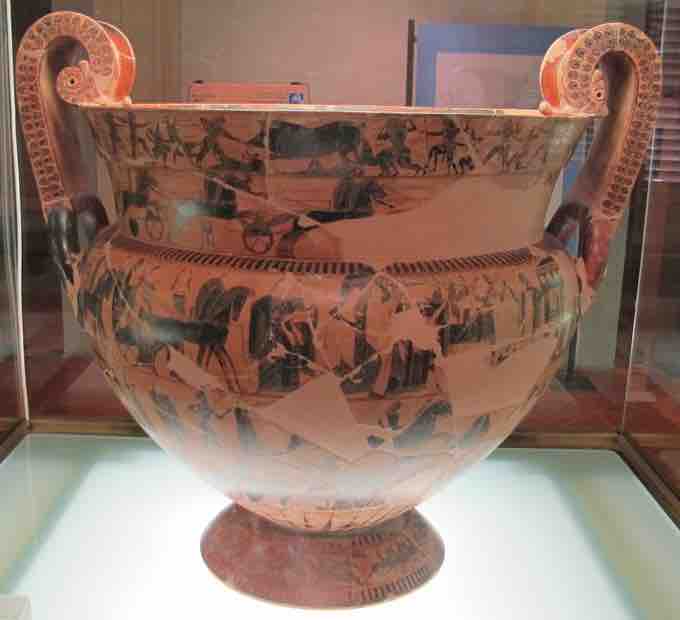
Francois Vase
Kleitias and Ergotimos. François Vase. Athenian black-figure volute krater. (c. 570 BCE. Chiusi, Italy. )
Exekias
Exekias, considered the most prominent black-figure painter of his time, worked between 545 and 530 BCE in Athens. He is regarded by art historians as an artistic visionary whose masterful use of incision and psychologically sensitive compositions mark him as one of the greatest of all Attic vase painters. His vessels display attention to detail and precise, intricate lines. Exekias is also well-known for reinterpreting mythologies. Instead of providing the entire story, as Kleitias did on the François Vase, he paints single scenes and relies on the viewer to interpret and understand the narrative. One example is an amphora that depicts Greek warriors Achilles and Ajax playing dice. Both men are decorated with fine incised details, showing elaborate textile patterns and almost every hair in place. As they wait for the next battle with the Trojans, their game foreshadows their fates. Inscribed text allows the two figures to speak: "Achilles has rolled a four, while Ajax rolled a three." Both men will die during the the Trojan War, but Achilles dies a hero while Ajax is consistently considered second best, eventually committing suicide.
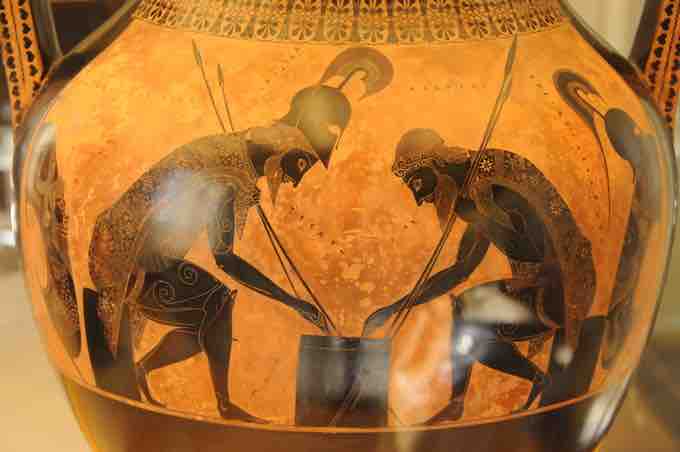
Achilles and Ajax
Exekias. Exhilles and Ajax Playing a Dice Game. Athenian Black-figure amphora. (c. 540-530 BCE. Vulci, Italy. )
Red-Figure Painting
Red-figure painting developed in Athens in 530 BCE and remained popular into the Classical period. The technique is similar to black-figure painting but with key differences. Instead of painting a figure with black slip and using a burin to scrape away the slip to create details, red-figure painting has the background painted black and the figures left the red color of the terra cotta. Black slip was painted with a brush to add detail. Brushes could achieve more fluid lines than a burin, so details were better rendered and figures became livelier than the black-figure silhouettes. The black slip could also be diluted with water to create shades for modeling bodies or clothing. Overall, the technique allowed vase painters to create compositions that rendered the body more naturally.
Bilingual Painting
Bilingual vase painting became popular with the advent of red-figure painting. Bilingual vases were painted with a single scene on each side of the vessel, usually the same scene rendered twice. One side depicted the scene in black-figure and the other side depicted the scene in red-figure. The Andokides Painter is credited as the inventor of red-figure style and its early production on bilingual vases. Several of his bilingual amphorae mimic some of Exekias's most famous subjects, such as Achilles and Ajax playing dice. These similarities lead many scholars to conclude that he was Exekias's student.
A score of vases with black figures, whose attribution is disputed by some researchers, show that the Andokides painter gradually attained greater control and virtuosity in the technique. Earlier examples appear a little stiff. Later, the artist exploits the benefits inherent in the technique, utilizing a range of colors from red to dark brown. The Andokides painter marked the arrival of the red figure style that was later used by many artists. The painter's most favored subject matter was a wide range of mythological scenes depicting the gods and heroes. Heracles was his favorite character.
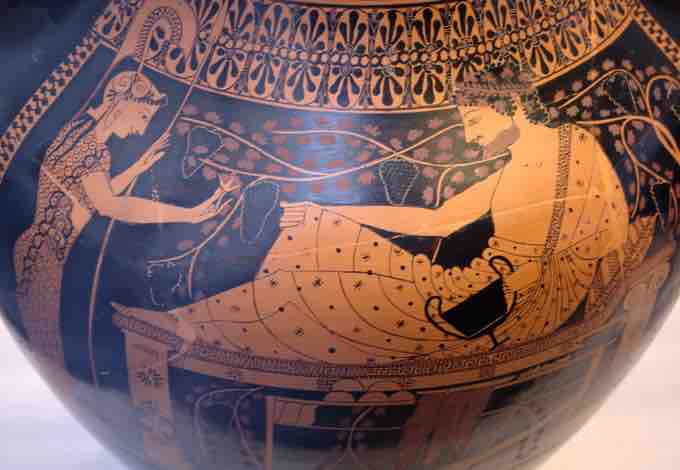
Herakles and Athena
Herakles and Athena. Red-figure side of a bilingual amphora. (c. 520-510 BCE. Vulci, Italy. )
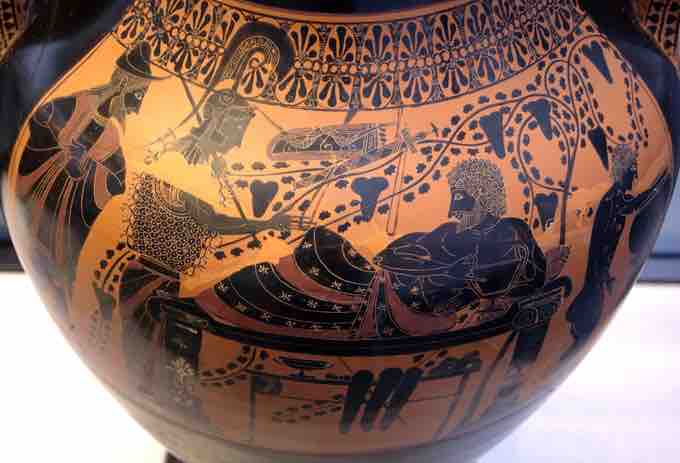
Herakles and Athena
Herakles and Athena. Black-figure side of a bilingual amphora. (c. 520-510 BCE. Vulci, Italy. )
Additional Red-Figure Painters
Additional red-figure painting can be seen in the work of rivals Euthymides and Euphronios. Euthymides is known as a pioneer of red-figure painting. His vessels depict people in movement and he attempted perspective by showing figures with foreshortened limbs. The Revelers Vase is an amphora that depicts three drunk men dancing. While the figures do not overlap, the bodies are in shown in profile, three-quarter view, and from behind. Breaking the traditional rigidity of contemporary Archaic statues and paintings, the revelers are in dynamic postures. The two outer figures stand in active stances, with their legs and hands in motion. The middle figure is in a twisted position, with his back to the viewer and his head looking over his left shoulder. The use of foreshortening, although rudimentary, gives the entire composition a more natural and believable feel. It is perhaps the use of this relatively untried technique that led Euthymides to write on his vase, “As never Euphronios [could do!]” as a taunt to his contemporary and rival.
Euthymides. Revelers Vase
Red-figure amphora. c. 510 BCE.
The painter Euphronios is also recognized for his dramatic and complex compositions. Diluted clay slip created a range of shades to color his figures, making them appear energetic and present in three-dimensional space. A scene of Herakles and Antaios wrestling conveys the bodies' of both men with previously-unseen naturalism. The men's bodies bend and twist and their limbs overlap, disappearing and reappearing, which helps achieve both naturalism as well as a sense of space.
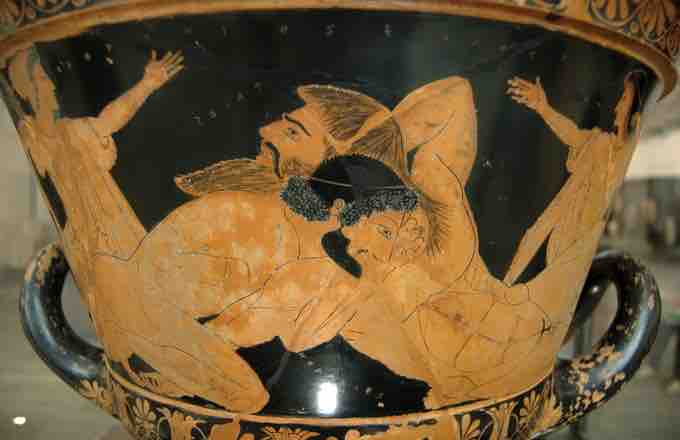
Herakles and Antaios
Euphronios. Herakles Wrestling Antaios. Athenian Red-figure calyx krater. (Ca. 510 BCE. Cervetri, Italy. )